Sigiriya - what is it? A 'Garden of Eden' or The Fountains of Paradise?
More mysteries of Sigiriya: The Mirror Wall, frescoes in the sky, balanced stone of thousands of tones weight, reptilian paws of Ishtar Goddess, miracle inhuman pool and pyramid on the top of a rock with unexpected guards.
This is a continuation of the
Detailed Photo Essay on Sigiriya, or Lion's Rock,
in Sri Lanka: Thoughts and Impressions of My Visit.
Chapter 1.
Detailed Photo Essay on Sigiriya, or Lion's Rock,
in Sri Lanka: Thoughts and Impressions of My Visit.
Chapter 1.
3. Sheer rock with path along it, fenced by the Mirror Wall - the lower part of the Sigiriya rock, 3-rd level.
Steep stairs made of bricks and already familiar to us marble steps led us to a steep rock of Sigiriya, and ascent was began.
Observation: Path is stone-paved by marble plates and fenced from the abyss by the Mirror Wall made of "some kind of porcelain", as described in official sources. Such a name as Mirror Wall was given to wall because it was polished so splendidly that ancient people were able to see their reflection on it, during walking along the path. There are many verses on the wall, scratched on it by people of old with some sharp and thin tools.
Impression: the Mirror Wall, made of "some kind of porcelain", is surpassed all imagination. Currently I am working for porcelain stoneware factory and know very well, how difficult (I mean impossible) it is to make "some porcelain thing" by the size of couple hundred meters. For example, we burn our porcelain stoneware tiles in kiln (gas-furnace) at the temperature of 1200 Centigrade's, and even small differences in burning conditions causes many defects of the surface of porcelain. What the great kiln it was, to burn properly porcelain wall of many hundred meters length?!?
The Mirror Wall looks very good, despite of gone thousands of years - surface texture, color, evenness of dyeing look like newly made. Numerous, but barely noticeable scratches (ancient writings from 8 century AD) don't count.
Main part of Mirror Wall is perfectly smooth, perfectly vertical (what simply can be seen on hanging everywhere "adjusting tools"-plummets), but in a projection from the top has a wavy shape.
The amplitude of the wave (the curvature of the undulating walls) such big that a hiding man could not be seen from the far end of the "corridor", on the same time the Mirror Wall visually looks flat. The guard successfully demonstrated it to us. By the way, the guard is armed; and there are numerous plates hanging everywhere with warnings that damage of monuments may cause criminal punishment down to the death penalty.
| View from the Mirror Wall – panorama photograph. |
Not less shocking and amazing part of level 3 are frescoes, painted on the lower part of the "visor" (a rocky prominence), overhanging the rock at a height of some 20 meters above the Mirror Wall. We climbed there by the spiral metal staircase.
Plastered granite with frescoes on it, hanging in the emptiness on a cliff, at a height of over 50 meters above the ground – for whom, what for? For observing frescoes with a telescope from the ground? There were no stairs long ago; there are no evidences of it on the stone. Once upon a time there were about 500 frescos, but only a few survived. Amazingly bright colors not faded for fifteen hundred years, magnificent, unique technique of painting… At least I haven’t seen analogues (something exact similar to this technique) in any other culture of civilizations of that time, before or even after. Beautiful girls' topless, painstakingly rendered features of facial expressions, hats, jewelry, flowers are charming.
Frescoes soaring in the sky…Frescoes with graffiti of ancient Ladies are one of the most enigmatic mysteries of Sigiriya, Sri Lanka.
Impression: It also shows us a hidden part of human history, an alternative history, where humanity might be more developed than in modern times. I've seen the girls representing different ethnic groups: Lankan, Hindu, African, Chinese and even a Slavic. Judge for yourself…
Left the Mirror Wall behind us, we are moving along the stairs and reaching the staging site, which from the first view has nothing special, if there was no big stone, set on the far hillside.
Granite stone of elongated shape (with flat bottom and convex upper half-sphere) is about fifteen meters in diameter (by bottom) and mounted on the numerous thin stone supports. Let's consider roughly the weight of a stone. Volume of a ball with a radius of 7.5 m = 4/3 πr^3 ≈ 1766 m^3; since we have a half-sphere, dividing it by 2 = 883 m^3 and multiplying by the 2,600 kg/m^3 (granite density) we've get a weight of this "pebble" (bingo!) = 2,295 (almost two thousand and three hundred) tons!
So, we can see on the photo that stone of 2,300 tons weight was installed on the numerous thin stone "columns" with incline from the skyline at an angle of 25-27 degrees and cannot be of natural origin.
For installation of these thin stone "columns" the constructors had to cut special deep grooves in a bottom-rock. And they had made "columns" and mounted the stone taking into account its surface irregularities, adjusting supports tightly to its bottom. Once installed on the "columns", our large stone had spent thousands of years successfully, despite the seismic activity and the numerous earthquakes that have taken place over the years. There are also many apertures of square shape and small depth on the surface of this stone and the rock beneath it. It is fair to say that the constructors had no problems at all with such sciences as an "engineering mechanics" and "resistance of materials".
The guide suggested that the Stone had been set there with a defensive purpose. Supposedly when the enemy attacks, "columns" should be broken and the stone shall slip on the heads of the attackers. There immediately raise two questions about his suggestion: how often it was pushed and dropped on the heads of enemies, and how it was installed there?
Impression: in the present time installation of this stone on this particular place would be impossible, because it is impossible to move there a hoisting crane that would be able to lift such a cargo. In case of assembling (and then disassembling) a hoisting crane in place, specifically for the installation of this stone, this activity would be full of idiocy, because result has no sense in comparison with spent for this budgets and resources. There arises a thought that to lift and move such cargoes was not especially difficult for the builders of the Sigiriya, the same as for the builders of the temple at Baalbek (Lebanon) or Machu Picchu (Peru), for instance.
Suggestion: this "stone on columns" might be used as a seismic detector. Why not? It makes some sense. I will tell the reason of it later.
P.S. Commented later. I haven’t changed an original text of the article in purpose, in spite of the fact that the real meaning of this object is already known. I want to show you the train of thought in its original state. Because it reflects the accuracy of the assumption which insisted that it’s designed for registration of vibrations in some way.
In fact, this object is a tuning fork, resonator, designed for registration of presence of infrasound vibrations. There are a lot of similar objects scattered all around the world. For example, in Karelia (Finland) it is known as a SEID, “The Stone of Power”. These objects are usually placed not far from the prehistoric ruins of an objects with the megalithic polygonal masonry, evidences of unknown civilization of ancient “gods”. You can read about it here: The Star Gate of Sri Lanka.
P.S. Commented later. I haven’t changed an original text of the article in purpose, in spite of the fact that the real meaning of this object is already known. I want to show you the train of thought in its original state. Because it reflects the accuracy of the assumption which insisted that it’s designed for registration of vibrations in some way.
 |
| Karelian Seid, or "the Stone of Power" |
In fact, this object is a tuning fork, resonator, designed for registration of presence of infrasound vibrations. There are a lot of similar objects scattered all around the world. For example, in Karelia (Finland) it is known as a SEID, “The Stone of Power”. These objects are usually placed not far from the prehistoric ruins of an objects with the megalithic polygonal masonry, evidences of unknown civilization of ancient “gods”. You can read about it here: The Star Gate of Sri Lanka.
Reference (information from Wikipedia): currently, LR13000 (on the picture below) is the largest hoisting crane in the world that is able to move independently. Its carrying capacity is 3,000 tons. This machine can lift up a cargo to a height of 12 meters.
The main purpose of this large machine is the construction of chemical and petroleum plants. Crane lifts and install chemical reactors and distillation columns, weighing up to 1,500 tons. Also such cranes are used in construction of nuclear facilities, where large blocks must be raised and installed.
4. The "Lion Gate" or "Lion Staircase" and rise from the middle to the top of the Sigiriya cliff - the fourth level.
After the "stone on columns" staircase leads us on a broad platform, which decoration gave the name to the Sigiriya cliff (Singh, meaning Lion.) Metal ladder, which begins between the enormous, carved out of granite paws, leads up to the top of the cliff. They say that the "Lion" previously had a head, and way up was laying thru the jaws. But then the head allegedly "fell off" and nobody knows where it is now. Modern steel staircase was probably built in the same place where ancient one used to be. Evidences of this can be seen on the surface of the cliff as cut deep furrows, apertures and other traces of rock processing.
Impression: paws seem not quite of lion-like, they not catlike at all. There are three fingers with enormous claws, fourth finger is rudimentary. Lift of foots is very high, not typical for breeds of cats. More like paws of reptiles. By browsing the Internet forums dedicated to Sigiriya researches, I have found sustainable felt that it is too similar to the dinosaur's paw. For example, Troodon paws, although you can argue about this forever.
As an alternative these foot might belong to Ishtar or Inanna, Goddess of the ancient Sumerians.
 |
| Old Babylonian period Queen of Night relief, often considered to represent an aspect of Ishtar. |
Again, where is the head? Had it fallen off or collapsed? If so, there would have been wrecks, lumps and ruins. But nothing is there. Where had it been lost? Maybe the whole head had rolled down, to the precipice opposite to paws? I walked there, peeping out over a cliff down into the jungle. I saw the edge of huge stone sticking out of trees, but nothing was clear and it looked like nothing on Earth. In addition, if the head of thousands tones weight has fallen off and rolled down, it would have swept away everything bucked on its way, all these bricks and the terrace, ground and a primer on it, leaving a very noticeable mark.
Here we come up with an idea that if the "lions head" was made of the same granite stone as paws, the bricks terrace in front of the feet was constructed much later the head has fallen off, as well as other bricks constructions there. There is another sustainable sense that fifteen hundred years ago King Kashyapa simply ordered to build bricks stuff around something that existed long before that and were abandoned long ago.
5. Ramped pyramid on top of the Sigiriya rock, gardens, swimming pools and demons-keepers on the fifth, upper level.
When we got to the top of Sigiriya rock, my opinion that there have never been any palaces became even stronger. There is just ramped pyramidal structure with lots of terraces and stairs. There are also splendid, magnificent swimming pool and several smaller basins. As I said before, the size of the top pyramid platform is 17 by 11 meters (area of 187 square meters). There is a path around the perimeter of the site, paved with ancient slabs of white marble, and a single marble stone protruding from the ground as a mooring site. Two stairs, leads on the flat top, placed from the sides opposite to the main stair (the entrance to the top from the lower level of the rock) and the lower cascade of first level gardens (to prevent anybody peep with binoculars at the Gods, who descends from heaven to Earth, probably :-).
We were very surprised by the dogs, sleeping on the top. There were two of them, as yin and yang. They were there, although it was not clear why, what for. They were not begging for food, not harassing to anyone, and not reacting to people. In terms of logic, even a dog's logic, there were absolutely nothing to do for them, there were nothing to catch and hunt. All food was downstairs, in café at the entrance to Sigiriya complex. But for unknown reason they deliberately climbed to the top of Sigiriya ramped pyramid and either slept or were leisurely wandering along it. From time to time there it seems to relieve the guard - later we met on the stairs dog going up to the top, with a look as if it knows exactly where to go and why, and the other went down. Probably, this is such a service, as they guarded something there.
There are no evidences of palace, just stairs, terraces, ramped ledges of bricks. The width of the marble steps – like half the length of my foot (I have a fair 45 size (US – 11.5). There is no place for living quarters or storage facilities. But I've found there one more "throne" carved out of granite rock.
Impression: this is not a throne; this is a garden bench to sit on it, admiring the scenery. Why? There are no grounds (place) in front of the "throne", where someone could kneeling or receive valuable guidance. There is only precipice, several ledges and marble staircase in a one meter wide, just to walk alone.
I was fighting with desire to use this "throne" as a sofa-bed. The same design, the same high-quality, perfect processing of granite rock. Horizontal stripes on the back of the throne can be considered as signs of passages of the cutting tool. Or maybe it is just structure of a stone…
I want to separately highlight the unique large pool, entirely carved in granite rock. With two sides going down the slopes of the cliff, the pool is enclosed by a brick wall more than two meters in height.
 |
| High quality panorama photograph of Unique Granite Pool wholly carved in rock on the summit of Sigiriya. |
And now I propose to your attention a bit of arithmetic, to imagine the enormous work and labor-intensiveness in the construction of the swimming pool.
Pool has the following dimensions: length – 27.7 m; width — 20.72 m; Height granite rock over the water in the corner which is closest to the top of the pyramid is not less than 3 m, from the opposite diagonal – 0 m, so the calculations take average 1.5 m.
Depth of the pool is approximately 2 m, I could not to do more precisely measure, therefore, accept this value.
So, the volume of granite, removed during the carving of a pool = 27.7 x 20.72 x 3.5 = 2,009 m^3.
The density of granite is 2600 kg/m^3.
So, total weight of granite, removed during construction of the pool = 2009 x 2600 = 5,223.4 tons!
An interesting observation #1: manufacturing process of large granite formations removing involves: firstly – drilling a deep holes along the estimated line of granite splitting and then (ancient version) – hammering in there wooden wedges, which swelling when pooling water on them and thus breaking away the granite layer, or (according to the modern method) placing an explosive in a drilled cavity and breaking the stone layer by its detonation. In both methods characteristic traces remain on the surface of the cutting granite, which in this case I did not notice at all. Version with circular saw is not suitable, because the surface of the granite rock looks like "moderate natural." In addition, the drainage system is still working. It has been raining that day; the pool was full of water, but not crowded.
An interesting observation #2: Pay attention to the places indicated by arrows.
There is a staircase at the far end of the pool (towards the center of the pyramid) carved in the granite rock and leading up from the water to the carved in the rock small platform, from which there is no exit. A second stairway leads to the right (along the smaller side of the pool) on the same platform with no exit located exactly at the same level. If you look carefully, you can see that floor of these platforms located exactly on the same level as the top edge of the fence surrounding the pool.
There is the only logical explanation – these stairs with space-closed platforms were intended solely for the following: while swimming in the pool, you could quickly climb to the level above the fence and see – what is happening outside there and is there happened something very important, worth enough to run from the water as to be bitten in an ass? I don't see any other explanation. But where shall you to look in that direction? Down? There is nothing interesting, just the jungle, the same as in all directions.
It is very interesting, that a coverage area from those platforms allows you to see the sky above the horizon from East over the ancient Polonnaruwa city (28 km as the crow flies, may be interesting for us because of ancient temple with polygonal masonry of megalithic blocks on the principle of processing all megaliths, i.e. cutting granite on the place like a knife through butter) to the South, in the direction of Adam's peak (Sri Pada mountain, 130 km as the crow flies).
Speaking of Adam's Peak, there is a feeling of strong, stable relationship of this sacred place with the Sigiriya, the heart of Sri Lanka. In amazing way this mysterious place became the object of worship of all represented here four religions: Hinduism, Buddhism, Islam and Christianity. With some exaggeration it may be called the one of the most venerated sites in the world. The prominent rock at the top of this mountain has the sacred footprint. Hinduists believe that the footprint has been left by the dancing Supreme God Shiva during the creation of the world and called the mountain Shrivan adipate (the cosmic dance of Shiva).
Buddhists believe that the footprint belongs to Gautama Buddha, and Hindus have almost nothing to be said against it, because they believe in the Buddha as an incarnation (avatar) of the God Vishnu. In Islam, it is considered that Adam set foot on Earth exactly on this place after the expulsion from Eden. By the way, Muslims very revered Adam, considering him to be the representative of the God on Earth, the first of his Prophet and the creator of sacred stone of the Kaaba in Mecca.
An interesting detail: thousands and thousands of butterflies are gathering on this mountain every year, in the last hours of theirs life, to die on the slopes of the Adam's Peak. They say this is very beautiful show. Because of this, the Sinhala name of the mountain is Samanalakanda, which refers to the butterflies (samanalayā).
There is the only logical explanation – these stairs with space-closed platforms were intended solely for the following: while swimming in the pool, you could quickly climb to the level above the fence and see – what is happening outside there and is there happened something very important, worth enough to run from the water as to be bitten in an ass? I don't see any other explanation. But where shall you to look in that direction? Down? There is nothing interesting, just the jungle, the same as in all directions.
It is very interesting, that a coverage area from those platforms allows you to see the sky above the horizon from East over the ancient Polonnaruwa city (28 km as the crow flies, may be interesting for us because of ancient temple with polygonal masonry of megalithic blocks on the principle of processing all megaliths, i.e. cutting granite on the place like a knife through butter) to the South, in the direction of Adam's peak (Sri Pada mountain, 130 km as the crow flies).
Speaking of Adam's Peak, there is a feeling of strong, stable relationship of this sacred place with the Sigiriya, the heart of Sri Lanka. In amazing way this mysterious place became the object of worship of all represented here four religions: Hinduism, Buddhism, Islam and Christianity. With some exaggeration it may be called the one of the most venerated sites in the world. The prominent rock at the top of this mountain has the sacred footprint. Hinduists believe that the footprint has been left by the dancing Supreme God Shiva during the creation of the world and called the mountain Shrivan adipate (the cosmic dance of Shiva).
Buddhists believe that the footprint belongs to Gautama Buddha, and Hindus have almost nothing to be said against it, because they believe in the Buddha as an incarnation (avatar) of the God Vishnu. In Islam, it is considered that Adam set foot on Earth exactly on this place after the expulsion from Eden. By the way, Muslims very revered Adam, considering him to be the representative of the God on Earth, the first of his Prophet and the creator of sacred stone of the Kaaba in Mecca.
An interesting detail: thousands and thousands of butterflies are gathering on this mountain every year, in the last hours of theirs life, to die on the slopes of the Adam's Peak. They say this is very beautiful show. Because of this, the Sinhala name of the mountain is Samanalakanda, which refers to the butterflies (samanalayā).
Also Sigiriya is used as the location of many of the events in the science-fiction novel The Fountains of Paradise by Arthur C. Clarke, although Clarke changed the name to Yakkagala ("Demon Rock") in the book.
Summing up, I recognized that a visit to the Sigiriya raised in my heart strong feelings that its magical gardens with equal probability could be the Paradise Gardens of Eden, from which Adam was banished in ancient times or ancient recreation area, Resort of the Gods, unapproachable and safe, where the living Gods would descend from the heavens, parking their sky-chariots "vimana" on the top platform of the pyramid. Or maybe both of these purposes at the same time.
Version of the construction of the Palace for the King Kashyapa by slaves over a short period of several years, looks at least fabulously due to the huge amount of work, the unexplained, the unavailable for man technologies and just lack of common sense in building such a grandiose theme park that just could not be built to be a Palace, in terms of the elementary principles of architecture and construction.
Logically, we may classify all of things that built on the Sigiriya by three main parts by presumptive periods of time:
1. The most ancient: these are everything that wholly carved out of granite rocks with great, advanced technology, beyond the reach of modern granite processing and other technologies. For example Thrones, Lion Paws, pools with evidences of machine processing, huge stone on columns, etc. May be dated even as the Antediluvian, I mean more than 12,000 years ago. Known to us analogues are oldest examples of polygonal masonry of Machu Picchu (Peru) and foundations (basis) of Baalbek Temple (Lebanon) and Solomon's Temple (Jerusalem).
2. The middle-ancient: stone-paved with white marble paths and staircase, the Mirror Wall, frescoes and everything that could be done with remaining of advanced technologies accessible to the humanity after the Flood. Built with the same technologies that were accessible, for example, to Sumer civilization. Period of time is about 6,000 – 4,000 years ago. Analogues: upper parts of described above objects in Peru, Baalbek and Jerusalem.
3. Constructions of Common Era: everything that King Kashyapa was able to build of red bricks on the remains of existing complex, deserted long time ago. Dated about 1,500 years ago.
It seems much more possible version that the King Kashyapa was able to use the existing complex, as his Palace – why not, he was a fugitive, and he could not have a choice (or/and more elegant place). But it is unlikely that he had out there the Imperial comfort, being forced to regularly climb to great heights and staying in the wooden bunkhouses on the terraces of the ramped pyramid of majestic Sigiriya.
Summing up, I recognized that a visit to the Sigiriya raised in my heart strong feelings that its magical gardens with equal probability could be the Paradise Gardens of Eden, from which Adam was banished in ancient times or ancient recreation area, Resort of the Gods, unapproachable and safe, where the living Gods would descend from the heavens, parking their sky-chariots "vimana" on the top platform of the pyramid. Or maybe both of these purposes at the same time.
Version of the construction of the Palace for the King Kashyapa by slaves over a short period of several years, looks at least fabulously due to the huge amount of work, the unexplained, the unavailable for man technologies and just lack of common sense in building such a grandiose theme park that just could not be built to be a Palace, in terms of the elementary principles of architecture and construction.
Logically, we may classify all of things that built on the Sigiriya by three main parts by presumptive periods of time:
1. The most ancient: these are everything that wholly carved out of granite rocks with great, advanced technology, beyond the reach of modern granite processing and other technologies. For example Thrones, Lion Paws, pools with evidences of machine processing, huge stone on columns, etc. May be dated even as the Antediluvian, I mean more than 12,000 years ago. Known to us analogues are oldest examples of polygonal masonry of Machu Picchu (Peru) and foundations (basis) of Baalbek Temple (Lebanon) and Solomon's Temple (Jerusalem).
2. The middle-ancient: stone-paved with white marble paths and staircase, the Mirror Wall, frescoes and everything that could be done with remaining of advanced technologies accessible to the humanity after the Flood. Built with the same technologies that were accessible, for example, to Sumer civilization. Period of time is about 6,000 – 4,000 years ago. Analogues: upper parts of described above objects in Peru, Baalbek and Jerusalem.
3. Constructions of Common Era: everything that King Kashyapa was able to build of red bricks on the remains of existing complex, deserted long time ago. Dated about 1,500 years ago.
It seems much more possible version that the King Kashyapa was able to use the existing complex, as his Palace – why not, he was a fugitive, and he could not have a choice (or/and more elegant place). But it is unlikely that he had out there the Imperial comfort, being forced to regularly climb to great heights and staying in the wooden bunkhouses on the terraces of the ramped pyramid of majestic Sigiriya.
But there is even one more mystery of the Sigiriya, about which you can read in
Chapter 3: What Pidurangala is – a monastery in caves or an ancient Over-the-Horizon Early Warning Radar next to the Sigiriya "Lion's Rock"?
Chapter 3: What Pidurangala is – a monastery in caves or an ancient Over-the-Horizon Early Warning Radar next to the Sigiriya "Lion's Rock"?





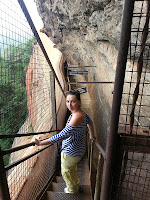
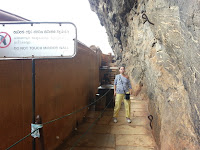


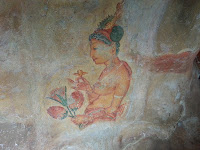













.jpg)
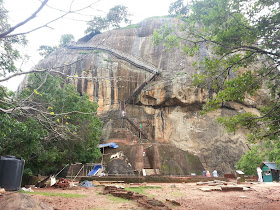

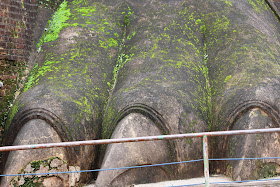




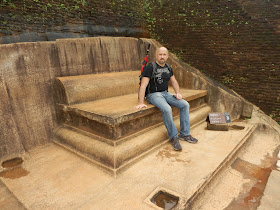

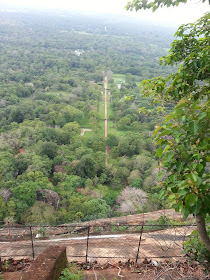

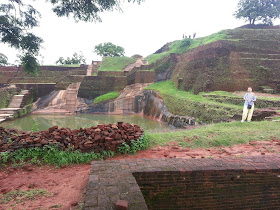

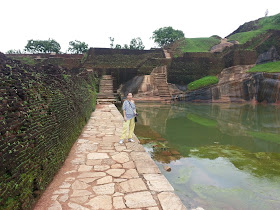
.jpg)
Don Vladimir Kovalev
ReplyDeleteThis second part of your report is so fascinating as the first.
Never the thought comes to mind from ordinary people such to modify these rocks as aesthetic resort. Some exceeds just the human virtue. It is, how you explain it.
The desire to modify the rock alone to the aesthetic enrichment or some other need comes from an other world. There is only one explanation as such as the use of technology. From where came the technique? By the gods!
The wall of porcelain and the frescos are impressive. Of course, each stage, the seating areas and many might not have discovered stone work are fantastic.Thanks again for such an excellent report on evidence from a time where beings familiar with technology inhabited our earth.
Josef Bauer
Dear Don Josef Bauer,
ReplyDeleteIt’s great to find a like-minded person, whose point of view on an ancient history of humanity is the same (basically), details don’t count.
It’s a fact that with development of such a wonderful instrument of communication as Internet, we obtain possibility to bring our thoughts to attention of people around the world. Also we have access to information from all parts of World. It’s great!
We are living in unique time! We can see evidences of ancient machine civilizations, which could be more advanced than our modern civilization of Human. We can draw our own conclusions, despite of official versions. Official opinion is very stiff, but sooner or later it would be impossible to hide facts and evidences that contradict to what we call History. A lot of things would be reviewed. It would give us new understanding of human origin, of what are we, where do we come from and where are we going.
It is a complicated question – are our ancestries were living gods (ancient aliens from other planet), or civilizations of Atlántida and Hyperborea, or both in the same time?
Anyway, it is my strong opinion that sensible person is able to see and understand that not all is clear in official history and some evidences like traces of granite processing in many places around the world, along with polygonal masonry of Machu Picchu, Great Pyramid, Baalbek, Sumerian heritage, ruined by nuclear blast Mohenjo-daro, etc. confirm the fact, that ancient civilizations of Earth could be more advanced than ours. Sumerian Version of creation of human as a labor force by living gods (Anunakis) also has the right to exist.
Process of looking for truth is interesting and exciting for me. If even one person found my story quite interesting that it set him thinking about questions of human origin, this was worthy of it…
Dear Vladimir,
ReplyDeleteAs a Sri Lankan i came across your blog while searching for some pictures about Sigiriya, im happy to see that you have noticed facts about Sigiriya that even most Sri Lankans have failed to realize, I hope you had a great stay in my beautiful country. Cheers
great research report
ReplyDeleteyou've done a great job here.
for your information and to expand this research I'll give you a tip on which calla lions feet.
find about kashyapa thero in lord Buddha's time. whose place is called gurulu pada lena. in English the stone cave which has a birds foot.
gurula is a mysterious bird. this feet which exactly looks like a birds feet. but if you really gonna do the research you've to find more about Buddhist history.
all the best with your research.
And there is an inscription on sigiriya which has published in inscriptions of Ceylon.
ReplyDeleteI strongly agree with you on present history is not accurate and i admire the people like you for dedicating to figure out the true history in my country.
but remember sri lanka's history is based on buddhism all other religions are lately introduced to sri lanka. if you need to find true history do researches on the buddhist history.
Tharindu madusanka, thanks for an interesting comment!
ReplyDeleteDear Mr. Kovalev, we as Sri Lankans are very thankful to you for the above observations and for the extent you have gone to justify your theories. In fact a lot of new research is currently in progress and you will be amazed by some of the findings. I would love to connect you with some of them but I am sure that you will be able to browse through and find out for yourself
ReplyDeleteThanks! If you have something to say, feel free to contact me!
DeleteHi Vladimir Kovalev,
ReplyDeleteWhat a series of great articles. It really opens every ones eyes,
Thanks! One more article is coming soon.
DeleteThank you for your report and the excellent photographs!
ReplyDeleteAs a best thanks – tapping a +1 Google Button is gladly accepted! :-)
DeleteDear Vladimir,
ReplyDeleteThanks lot for your article and well done. I have been to Sigiria twice and never seen the way you have seen it and it’s amazing. Your article encourages me to visit Sigiria again and observe your points. Keep up your good work want to see more from you. Thanks on behalf all the Sri Lankans.
Ruwan Pathiranage
Melbourne
Dear Chinthaka Godauda,
DeleteThank you!
nice article vladimir ..i also have the question abt the feet because it certainly does not look like a lion's more like a reptile's ..anyway keep up the good work
ReplyDeleteThank you, buddhima.hasantha!
ReplyDeleteDear Vladimir,
ReplyDeleteI thought to share what i heard from different sources regarding "stone on columns". Those were setup to destroy enemies by releasing giant piece of stones on them. Also i heard that there were simple release locks for each trap. Those "stone" were setup in many directions where enemy attacks were possible. This a know guerrilla fighting technique that have been used by "Sinhala" people. Same techniques has been used even in 1800 against British invaders.
The king Karshyapa who built this amazing rock fortress, lived with great fear because of his acts. He killed his father (former king) & was expecting attack from his brother, also people were not with the king too.
It is really nice article. keep it up the good work.
Dear Vladimir,
ReplyDeleteAlthough I am a Sri Lankan I started from Egypt pyramids and end it with our Sigiriya. This is fantastic. I love it and I live in it now.
Are you here in Sri Lanka still?
Thank you for your huge effort....
Dear Kasthuri Prasad, thank you. I’ve just once been to Sri Lanka. I live in Ukraine.
DeleteDear Mr Kovalsky,
ReplyDeleteI also notice the step width being half the size of an average adult foot, either people of that era had small feet or it was intended to avoid rushing or running up or down... and the marble making it slippery too.
{ The width of the marble steps – like half the length of my foot (I have a fair 45 size (US – 11.5).}
also the top level could be considered as an airport, waiting lounge.
Regards
Sujeevan
Hi Mr Kovalsky,
ReplyDeleteGood that you visited Sigiriya and given your findings above.
But you might have missed some important facts.
You have noted that, never seen any evidence that palace was there on top of the rock. That’s true.
Because its inside the rock.
You have seen that the ‘Lion’s Paw’, which is not really look like lion’s paw. Rather it’s a reptiles.
Also have you noticed that the material used to build that paw’s and surroundings?
Which are not even relevant to any other rock carvings. And it’s a separately build wall in front of the rock?
The truth covers by a British treasure hunter, with reptiles paw and a brick wall.
Looted whole palace gold and other artifacts and taken to Britain.
When you go near there, you can find the truth. This wall built recently not centuries ago.
Invitation for you to explore again. Your finding will create a new side of a history.
@Sujeevan, refers to "The width of the marble steps – like half the length of my foot...."
ReplyDeleteThis is not a foot path or climbing steps for humans.
This is for an elevator (lift).
Which used to go up on the rock.
The rotatory will move up on those steps
hi RavanaLanka. What you mentioned about Sigiriya especially the stairs / steps for a lift is very interesting, I like to know if it is possible for me to talk with you either over the phone or can meet. I live in Colombo.
DeletePlease reply
Rumor has it there is a secret passage way leading to a inner area of the rock. And the ancient book called Mahavansha discribes a machine called Karkataka (Crab) which was used to take heavy things to the top.
ReplyDeleteVlad,
ReplyDeleteHope every thing is well. Great stuff. Sri Lanka wishes you and your family a long and prosperous life.
Are you still checking the comments Kolvalsky
ReplyDeleteW.O.L.F.
If you have time id like to ask a few questions.Your work is very interesting.
ReplyDeleteW.O.L.F.
Yes, sometimes I check comments, but quite rarely. I do not have enough time for this, unfortunately.
DeleteThis is Ravana's fortress
ReplyDeleteHey I'm from sri Lanka
ReplyDeletei have to talk with you
About sigiriya
Sigiriya was......